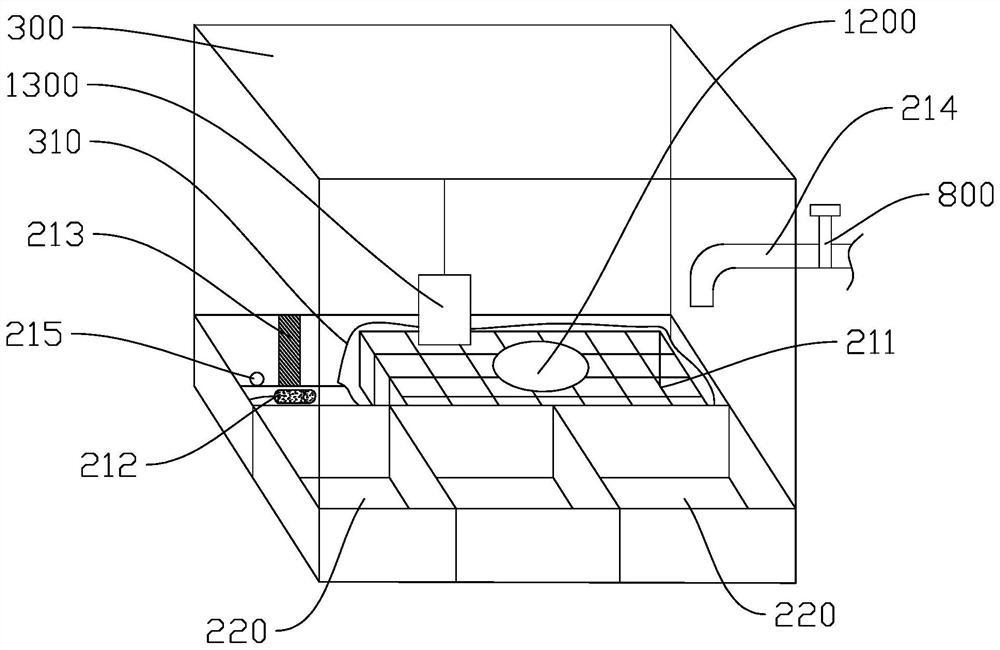Culicoides breeding method and culicoides culture device and application thereof
A breeding method and technology of Culicoides, applied in the fields of application, botanical equipment and methods, horticulture, etc., can solve the problems of difficulty in ensuring sufficient number of Culicoides with strong vitality at any time, not suitable for large-scale breeding, and many operations. , to shorten the research and development cycle, save manpower and time, and increase the number of eggs laid.
- Summary
- Abstract
- Description
- Claims
- Application Information
AI Technical Summary
Problems solved by technology
Method used
Image
Examples
Embodiment 1
[0061] The cultivation method of the Culicoides of the present embodiment may further comprise the steps:
[0062] Incubation: place a layer of 80-mesh nylon cloth 310 on the stainless steel shelf 211 of the hatching basin 210 in the culture device, add water (the water added in the hatching basin is tap water that has been left standing for 2 days) until the water surface is flush with the stainless steel shelf 211, but not completely Pass nylon cloth 310, water depth 7cm, get 5g larvae food A and put it on nylon cloth 310, turn on the air pump, inject air into the water through air stone 212, form the microenvironment suitable for the life of Culicoid larvae in hatching basin 210 after 4 days, will contain The filter paper 1200 of Culicoides eggs is placed on the nylon cloth 310 in the hatching basin 210, the temperature is controlled at 28° C., and the humidity is 80%, for hatching and rearing to obtain larvae;
[0063] Larva rearing: After the larvae are observed, add larv...
Embodiment 2
[0067] The cultivation method of the Culicoides of the present embodiment may further comprise the steps:
[0068] Incubation: place a layer of 80-mesh nylon cloth 310 on the stainless steel shelf 211 of the hatching basin 210 in the culture device, add water (the water added in the hatching basin is tap water that has been left standing for 2 days) until the water surface is flush with the stainless steel shelf 211, but not completely Pass nylon cloth 310, water depth 7cm, get 5g larvae food A and put it on nylon cloth 310, turn on the air pump, inject air into the water through air stone 212, form the microenvironment suitable for the life of Culicoid larvae in hatching basin 210 after 4 days, will contain The filter paper 1200 of Culicoides eggs is placed on the nylon cloth 310 in the hatching basin 210, the temperature is controlled at 28° C., and the humidity is 80%, for hatching and rearing to obtain larvae;
[0069] Larva rearing: After the larvae are observed, add larv...
PUM
 Login to View More
Login to View More Abstract
Description
Claims
Application Information
 Login to View More
Login to View More - R&D
- Intellectual Property
- Life Sciences
- Materials
- Tech Scout
- Unparalleled Data Quality
- Higher Quality Content
- 60% Fewer Hallucinations
Browse by: Latest US Patents, China's latest patents, Technical Efficacy Thesaurus, Application Domain, Technology Topic, Popular Technical Reports.
© 2025 PatSnap. All rights reserved.Legal|Privacy policy|Modern Slavery Act Transparency Statement|Sitemap|About US| Contact US: help@patsnap.com



